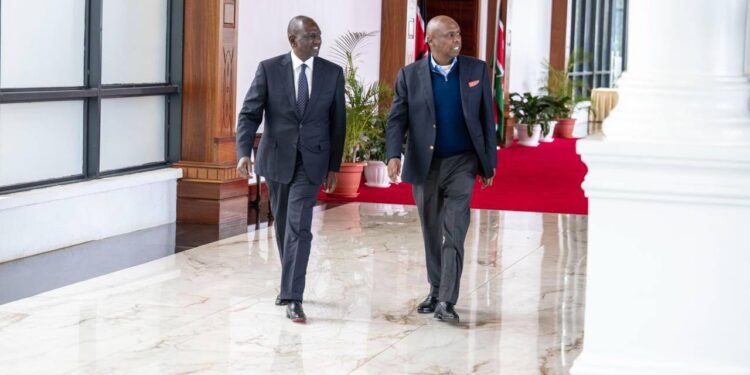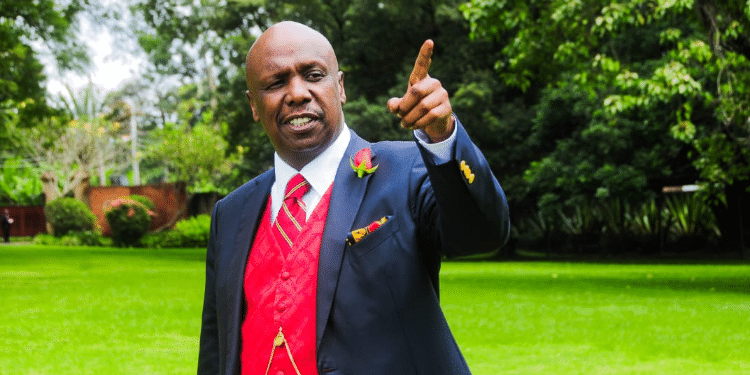
ODM leader Raila Odinga campaigning in Nyeri in 2022. Photo/X/Raila Odinga
By Newsflash Team
President William Ruto’s ongoing tour of the Mt Kenya region has sparked a heated debate over the authenticity of the massive crowds that turned up for his rallies.
While his allies insist that the support is genuine, critics claim that the turnouts are the result of heavy mobilization, including financial incentives and logistical support.
The discussion around the nature of these gatherings is not new. In past election cycles, similar questions have been raised about large crowds at rallies, with accusations of financial inducements and organized transport being common across the political divide.
Claims of mobilization and financial incentives
Videos circulating online have fueled suspicions that the crowds were not entirely organic. In one such video, a group of uniformed women is seen receiving money at the Laikipia East NG-CDF offices. This has led to claims that individuals were being paid to attend Ruto’s rallies. Additionally, some reports allege that the outlawed Mungiki sect played a role in mobilizing people, an accusation the government has strongly denied.
Read more: Ruto’s itinerary for Mt Kenya tour released
Further raising eyebrows, school buses were spotted ferrying people from different parts of the region, including Nairobi. Critics argue that this suggests a well-orchestrated plan to create the impression of overwhelming support.

Political analyst Mark Waweru notes that large crowds do not necessarily translate into genuine political backing. “We saw similar turnouts during Raila Odinga’s campaigns in Mt Kenya in 2022, but that did not convert into actual votes at the ballot box. Crowd attendance can be influenced by various factors, including curiosity, incentives, and even coercion,” Waweru observes.
Comparison with past political rallies
Those questioning the authenticity of Ruto’s crowds point to past political events for context. During the 2022 campaigns, opposition leader Raila Odinga managed to pull similar numbers in parts of Mt Kenya, despite the perception that he had little grassroots support in the region.
Political analyst Nancy Wanjiku explains, “A large crowd does not necessarily indicate popularity. Raila Odinga had significant turnouts, yet the election results showed a different reality. Political mobilization, logistics, and strategic incentives often play a role in how these gatherings unfold.”
Key Mt Kenya leaders missing in action
Adding another layer to the debate, some of Ruto’s key allies from Mt Kenya are conspicuously absent from his recent meetings. Kiharu MP Ndindi Nyoro, Ruto’s Senior member of his Council of Economic Advisors Moses Kuria, and former Public Service Cabinet Secretary Justin Muturi have avoided the events.
Nyoro’s absence was particularly notable, given his past strong support for Ruto. This has further fueled rumors that he is strategically positioning himself for the future, possibly as a counterforce to former Deputy President Rigathi Gachagua.
Read more:Ruto: I am mentoring Ndindi Nyoro
Gachagua, who has been vocal about power struggles in Mt Kenya, had earlier advised residents to take money being dished out by mobilizers but remain politically independent. “If they come with money, take it, but vote wisely,” Gachagua told a gathering in Naivasha, last week, further reinforcing claims that Ruto’s crowds may have been influenced by financial handouts.
Role of women politicians in mobilization
Some women leaders from the region have also been accused of playing a significant role in mobilizing crowds ahead of Ruto’s visit. Murang’a Woman Representative Betty Maina and Nyandarua’s Faith Gitau were reportedly distributing foodstuffs to locals in the run-up to the rallies. While their teams have defended these actions as community support initiatives, critics see them as an indirect way of influencing turnout.
Political commentator David Kimani weighs in, stating, “Food donations in a politically charged environment are rarely innocent. They serve as subtle incentives to get people to show up at rallies. This has been a common tactic in Kenyan politics.”
What this means for Ruto’s popularity in Mt Kenya
While the debate over crowd mobilization continues, the larger question remains: Is Ruto’s support in Mt Kenya intact, or is it diminishing?
Gachagua’s recent criticisms of Ruto, coupled with discontent among some local leaders, suggest that all is not well politically in the region.
Read more:Revealed: Why Kahiga attended Ruto’s meeting in Nyeri
If indeed mobilization have played a role in the turnout, it could indicate that Ruto’s grip on Mt Kenya is not as firm as it was during the 2022 elections.
“As political temperatures rise, the true test of Ruto’s support in the region will not be the size of his crowds but the decisions made at the ballot in the next election cycle,” says Kimani.
Image manipulation: Cambridge Analytica reports
There were reports that former President Uhuru Kenyatta and his then-deputy William Ruto engaged the services of Cambridge Analytica, a controversial data analytics firm, to manipulate voter perceptions during the 2017 elections by crafting targeted political messaging, distorting images, and using psychological profiling to influence public opinion and electoral outcomes.



